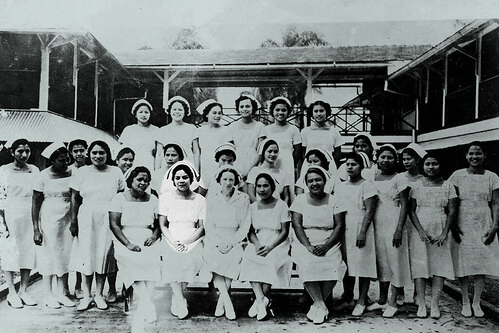Pioneer nurse
Amanda Pangelinan Guzman Shelton (1906-1982) was one of a handful of native Chamorro nurses who worked at the Naval Hospital in Hagåtña in the early American administration of Guam before World War II. Better known as “Mac,” Shelton was born 22 October 1906.
As a young woman Shelton made a commitment to help the sick, the children and the elderly. Her goal in life was to become a nurse. As a young child, Shelton wanted to wear white nurse’s cap and take care of an aunt who was very ill. The aunt was hospitalized in the Naval Hospital and Shelton was impressed by the gentle care and compassion of the hospital nurses during the early 1920s.
In 1922 at the age of sixteen she joined the Naval Hospital nurse-training program. Shelton’s parents had serious reservations about enrolling their child in the program because of the requirement that the young women in the program live at the hospital while in training. The head nurse, rather than parents, would have supervision of the trainees. Shelton sought advice and support of Maria Aguero who encouraged Shelton to continue her dream to be a nurse and assured the young woman’s parents that she would be a wonderful nurse. Shelton’s parents eventually relented and she was allowed to enter the program.
Shelton worked under the first Chief Native Nurse, Maria Roberto. Back then, it was the job of the chief nurse to work with the Navy nurses at the hospital and to supervise the training of the Chamorro nursing students. The chief native nurse was a principal, a teacher, a supervisor and a housemother. Her presence reassured the parents of the trainees that their daughters would be looked after while away from home. The chief native nurse also helped reassure that the students’ reputations would be protected in their interactions with Navy doctors and other male employees.
Shelton’s primary instruction as a nursing student was attending classes, making patients’ beds, bathing and feeding patients, and distributing medicine. Other duties included cleaning, mopping and changing bedpans.
Shelton was deeply saddened about three weeks before graduating from nursing school in 1924, when Naval doctors confirmed that Roberto had contracted Hansen’s disease (leprosy). The United States Naval government had a policy in place from 1912-1924 that all patients with leprosy be sent to a leper colony in Culion, Philippines. Roberto continued to work as a nurse assisting her fellow sufferers in Culion until her death there.
Shelton continued working diligently as a nurse under other Chief Native Nurses such as Dolores Lujan, Rita Pangelinan Garrido Blaz, Maria Duenas Sablan and Consuelo Terlaje Pellacani. Shelton herself became the Chief Native Nurse in 1934, through the Japanese occupation during World War II, and then again after the war, up until 1948. By then, the Naval Hospital had been destroyed.
As Chief Native Nurse, Shelton is remembered as a strict woman with a “kuatta,” or belt, for use when nurses got out of line. In her capacity, though, she also encouraged other young women to take up nursing as a professional career.
During World War II the Japanese had put Shelton in charge of a whole store of medical provisions and supplies so she could take care of the wounded and the sick if needed. According to historian Antonio Palomo, the local nurses were real heroines of the war. When the Japanese Occupation began, the nurses were ordered to continue working at the hospital in Hagatna. A rule was put in place that Japanese personnel receive medical care first before any local people. Because of this rule, sometimes the nurses would take medicine from the hospital to care for the locals in need of help. As Guam historian Anne Hattori has asserted, considerable evidence exists of native nurses administering medical care throughout the Japanese occupation. Indeed, the Chamorro nurses that were left behind to work with the Japanese showed that they had – and were respected for – their care-giving skills and knowledge.
Around June 1945 the US Naval Hospital School for Native Nurses was re-established. The following year it was renamed the US Naval Hospital School of Nursing, and later the Guam Memorial Hospital School for Nursing. The last class graduated in 1950 when the school closed after the signing of the Organic Act of 1950.
Eventually, Shelton took leave and traveled to the US continent where she met and soon married Austin James Shelton on 18 November 1947. They had one child, Austin James Shelton II, nicknamed “Sonny,” who eventually was elected senator in the 19th Guam Legislature. The Sheltons operated a family business together, called Shelton Music Company, which provided musical supplies and instruments for the island community for many years.
Amanda Guzman Shelton, as one of the Chamorro Chief Native Nurses, helped pioneer the nursing profession among Chamorro women. Her compassion and desire to help the sick and the suffering became an example for other Chamorro women to become nurses. Historically, Shelton’s experience at the nurse-training program highlights the shift of Chamorro women into careers outside of the domestic sphere and the impact of US naval health policies on the Chamorro people in the 20th century.
For further reading
DeLisle, Christine Taitano. “Navy Wives/Native Lives: The Cultural and Historical Relations between American Naval Wives and Chamorro Women in Guam, 1898-1945.” PhD diss., University of Michigan, 2008.
Hattori, Anne Perez. Colonial Dis-ease: U.S. Navy Health Policies and the Chamorros of Guam, 1898-1941. Pacific Islands Monograph Series 19. Honolulu: University of Hawai’i Press, 2004.
I Manfåyi: Who’s Who in Chamorro History. Vol. 1. The Hale’-ta Series. Hagåtña: Political Status Education and Coordinating Commission, 1995.





